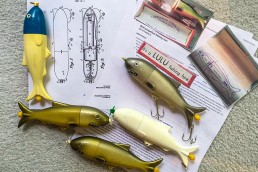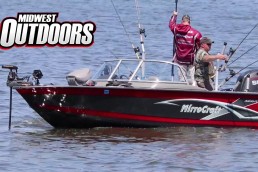The Real Lifelike Fishing Lures
SHARE THIS POST
“John, we’ve fished completely around Pim Island, a distance of 9 miles, and I’ve not seen a single muskrat or muskrat house in the weedy bays. Why?” I asked my guide, Johnny Ogoma.
“Mr. Gapen, too many big pike! Pike eat all the muskrats!” came Johnny’s startling response.
His answer made sense. I’d seen large pike attack a number of fur-bearing animals before. Once a large pike on the Asheweig River was noted following a mother beaver and her small kit. The pike swimming just under the surface persistently followed the pair as they swam from one shoreline to the other. Why the adult beaver would expose her kit to such an undertaking, I was at a loss to understand. Their house was on the shoreline she’d departed from. Maybe the presence of a large black bear that had been seen straddling the beaver house the day before was the reason. It was possible the bear had attempted to break into the mud, stick and log structure and this had given cause for the departure of the beaver. I’m not sure!
Nevertheless, the drama that was now taking place had exposed the kit to a hungry northern pike. The pike followed the pair until they reached the shoreline’s weed line, where I lost sight of them. Moments after gaining access to the weeds, there was a huge splash where I thought the beaver now swam. I didn’t see the pike actually grab the kit, but presumed it had happened. I’d noted the kit swam behind the mother as she gained access to the weed line. This positioning would have left the young beaver vulnerable to attack.
Evidence of what had just happened was noted in the next five minutes as the large mother beaver was seen swimming within the weed line in circular patterns, as if searching. My conclusion was that the large predator had struck the kit and eaten it.
Such incidents aren’t unusual in the wilderness where northern pike abound, even in muskie waters of our Northern states. Muskie have been seen attacking families of young waterfowl, intent on grabbing one of the newly hatched ducklings.
Why I bring such acts to print will be explained as you read on. While guiding as a teenager in the wilds of Northern Ontario, I was witness to a number of predator attacks on wildlife. One happened on a lake called Little Sturge. I was guiding a pair of anglers from Des Moines, Iowa. We were casting shoreline weeds for northern pike. So far we’d taken a good number of fish between 4 and 10 pounds. Suddenly, ahead of us, a mother Merganser duck rounded a shoreline point racing frantically towards us, her brood of nine following. They passed between us and shoreline. This was unusual! Normally, she would have avoided us by leading her brood out into the open lake.
“Gentlemen, I bet her ducklings were just attacked by a pike. Maybe she lost one of her brood,” I surmised as the duck family raced out of sight. Both men laughed, suggesting I was spoofing them.
A couple minutes later as we rounded the point my front angler hit a fish, a 10-pound pike. Upon landing it, an odd lump protruded from its stomach.
“Guys, I’ll bet that’s one of the mother duck’s young ones!” I commented. Both anglers seemed baffled by my analogy. Being only a half hour from shorelunch I decided to save the pike, cut it open and see what that lump really was.
Sure enough—as the lump was extracted from the pike’s stomach by a webbed foot, a duckling slipped into the open air, its eyes still blinking. Once again, my guests laughed; this time, one of them slapped the other’s shoulder and exclaimed “Well, I’ll be damned!”
Try as I might, the duckling couldn’t be revived, its eyes continuing to blink for 3 or 4 minutes. What was unusual about this happening was the size of the pike. It proved the voracity of this predator. At 10 pounds it already had begun to feed on larger critters than its normal style of fish food.
One last story to harden the conclusion I’ll come to at the end of this column. Are you aware that pike, as well as largemouth bass, love redwing blackbirds? Yup, it’s true!
Years ago, as I guided on a lake called English, the fact that northern pike will feed on blackbirds when given the opportunity became evident. This came to light one spring day when the pike were up in the red willows spawning. Along with the pike, a number of blackbirds were enjoying a feast of water bugs which swam the surface between those willows.
Are you enjoying this post?
You can be among the first to get the latest info on where to go, what to use and how to use it!
My guest, a doctor, was having a heck of a time trying to work his Dardevle spoon between those same willow branches.
“Doc, maybe you should try using a black surface bait instead of that snag-free spoon,” I commented after seeing a brightly-winged black bird disappear in a huge splash as a 15-pound pike launched itself and devoured the bird off a low branch perch.
“What are you talking about?” came the doctor’s answer to my suggestion.
“See that male black bird, the one with the scarlet red wing patch, fifty feet to your left. It’s sitting on a branch six inches off the water. Watch it! I just saw the water in front of it move” were my instructions to back up my comment.
No sooner had the doctor turned his head to eye the bird than there came the dark body of a near 20-pound pike as it exploded beneath the bird. A moment later, no bird and no pike.
“Well, I’ll be darned! Gapen, I would never have believed it,” he said as he turned to his tackle box in an attempt at locating a surface lure which would represent a black bird. Of course there wasn’t one, but he did find a black jitterbug which had been used for bass. It worked, but not nearly as well as I surmised a real blackbird lure would have. That day, out of around 100 birds we observed, four birds disappear to pike strikes. Year after year, at that time of year when the black birds descended to eat hatching waterbugs, the attacks by spawning pike reoccurred.
Now, the reason I bring these facts to my readers: there was a lure designer called the “Rat Man” who created surface lures out of muskrat skins and duck feathers. For the most part, he was laughed at by the angling public but I’m here to tell you his realistic lures worked, especially on trophy pike, muskie and largemouth bass.
An incident occurred right after Carl Malz, then editor of Fishing Facts magazine, and I were fishing for trophy pike on a lake called Havoc. Carl spied one of the Rat Man’s realistic muskrat lures in my box.
“Does that really work, Dan?” My answer was “Yup. I’ll troll across this bay and let’s see if we can dig up a big pike,” I responded.
Four minutes into the troll, right in the middle of the bay, there was an explosion 100 feet behind the boat. Minutes later I landed a 49 1/2-inch pike.
“See, Carl, I call this the Rat Man’s Revenge” was all I needed to say. Carl just mumbled something like, “Huh.”
Does the Rat Man still exist? I’m not sure! But if he reads this article in MidWest Outdoors, please get hold of me! I need some muskrat, duckling and black bird lures for those days when others in my tackle box don’t work.
My saying to pike anglers who’d call in to our resort in my guiding days asking the question “What lures do I bring?” My answer was—the biggest you have! Check the photo of Anne with a bright yellow Crankmaster.
Until next time, this is the Ol’ Man, Dan Gapen, Sr., hoping there are some awesome giant pike in your future.
MWO
SHARE THIS POST
Did you enjoy this post?
You can be among the first to get the latest info on where to go, what to use and how to use it!
Dan Gapen
Considered one of the world’s leading river anglers, Dan Gapen, Sr. has shared his knowledge with MidWest Outdoors readers and viewers for more than 40 years. He is a member of all three Fishing Halls of Fame—International, National Freshwater, and Minnesota. He has an immense grasp of the world’s fisheries. He may be contacted at 877-623-2099.
@TheGapenCompany.



